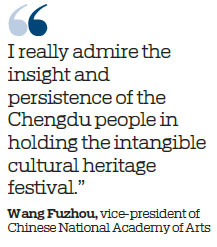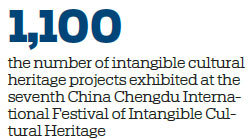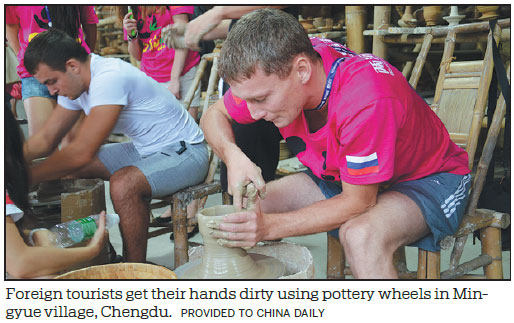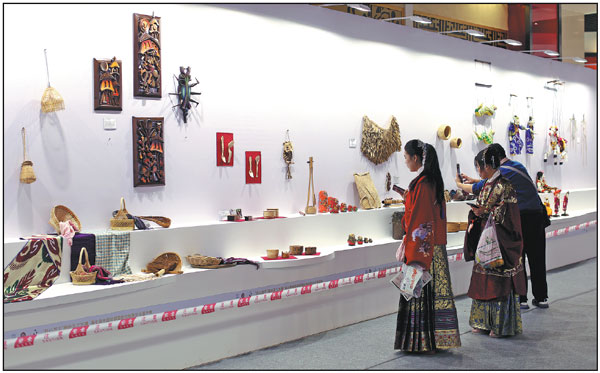Sino-French collaboration wows in Chengdu
East meets West in craftwork project that impressed visitors to cultural festival
A group of French and Chinese artists teamed up to create a true fusion of East meets West artwork, displayed at the seventh China Chengdu International Festival of Intangible Cultural Heritage from Oct 17 to 22.
The works showcased originated from a Sino-French traditional handicraft cooperation project named "New Classic of Mountains and Seas".
For the project, Eric Benque, a French artist, enlisted seven fellow artists to create half an artwork each using their Western stylings, only for the other half to be created by Chinese artists from Chengdu using traditional Chinese methods.
|
From left: A man demonstrates the techniques to make his national craft at the seventh China Chengdu International Festival of Intangible Cultural Heritage. Attendees show interest in embroidery at the festival. Children manipulate shadow puppets at the festival. Zhang Jinzhi / For China Daily |
|
Visitors admire handmade crafts exhibited at the seventh China Chengdu International Festival of Intangible Cultural Heritage. Provided to China Daily |
Since Sept 17, Benque has looked into many intangible cultural heritage items in Chengdu, including lacquerware, silver engraving, bamboo weaving and Shu embroidery.
He worked together with inheritors to create a series of original works with both Chinese and French characteristics.
Besides their work, nearly 90 intangible cultural heritage projects from 36 countries were showcased at the exhibition.
Also at the festival, Mingyue village in Pujiang, Chengdu was commended for the preservation of its traditions and practices.
Located 90 kilometers from downtown Chengdu, the village was impoverished before a local artist rediscovered an old Qiong kiln which inspired local residents to bring its old tradition of making ceramics back to life.

Qiong kilns were used widely during the Tang Dynasty (618-907) to bake ceramics, but early examples of them have been discovered dating back as far as the Eastern Jin Dynasty (317-420).
Ceramics produced in Sichuan's Qiong kilns have for centuries held a good reputation in China and often featured decorative patterns.
The kiln rediscovered in Mingyue had been used to make items such as earthen bowls, flowerpots and pickling jars since the Qing Dynasty (1644-1911).
The discovery of the Qiong kiln attracted the local government's attention, so they renamed it Mingyue Kiln and began a recovery project.
A team of workers spent a year completing the restoration. After the work was done, they built art studios, exhibition halls and tea rooms around the kiln to cater to potters, artists and visitors.
With word spreading of the kiln, the local government invited more than 100 ceramic artists and cultural industry experts to the village to ply their trade and build a creative cluster characterized by ceramic arts and other craftsmanship in the past few years.
Locals also seized the opportunity with many setting up ceramics-related businesses and B&Bs to cater to an influx of visitors.
The previously poor village welcomed 230,000 visits in 2018, generating a total income of 108 million yuan ($15.26 million). The per capita disposable income of the residents hit 21,876 yuan that year.
In July this year, Mingyue village was selected as the 2019 international sustainable development pilot community by the China Center for Urban Development and United Nations Human Settlements Programme.

With the first festival held in 2007, subsequent festivals are held every two years in Chengdu. It is China's only large-scale cultural festival sponsored by UNESCO, and the first such festival worldwide based on a theme of promoting the protection of intangible cultural heritage, organizers said.
The six-day festival attracted more than 1,100 intangible cultural heritage projects and 5,600 representatives from 86 countries and regions. More than 540 international exhibitions, forums, competitions, exhibitions and interactive experiences were also held.
As the host of the festival, Chengdu is striving to become a key destination for exhibitions and communication platforms for intangible cultural heritage, a Chengdu official said.
"I really admire the insight and persistence of the Chengdu people in holding the intangible cultural heritage festival," said Wang Fuzhou, vice-president of Chinese National Academy of Arts.
"Chengdu not only has the perseverance of inheriting intangible cultural heritage, but also the willingness of absorbing multi-sourced culture," Wang said.
Foreign representatives at the festival also expressed their appreciation of Chengdu's efforts in recent years. Salote Lupepauu Tuita Taione, executive director of Tonga-China Friendship Association said she saw many possibilities for cooperation in intangible cultural heritage with Chengdu in the near future.

(China Daily 10/25/2019 page19)
















